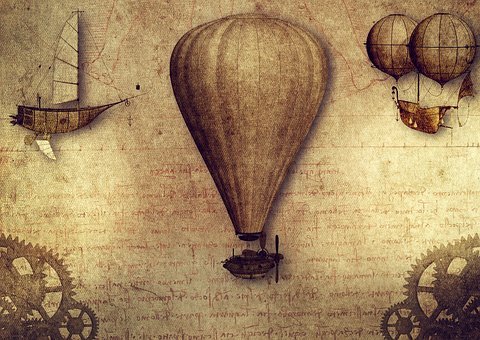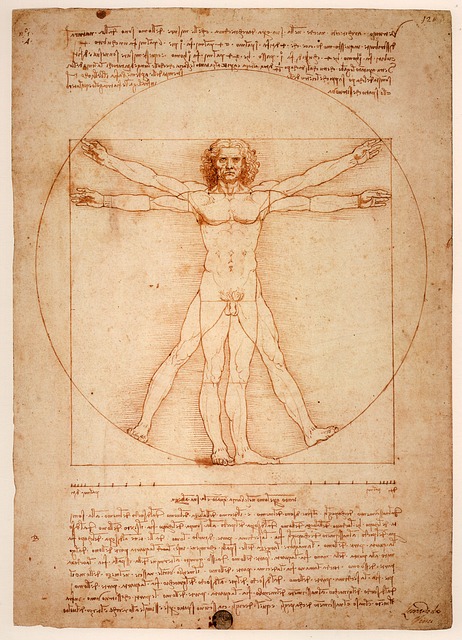To mark the 500 years since his death, the exhibition “Leonardo da Vinci – 500 years of a genius” opened in 2019. It is considered the most complete and detailed investigation of Leonardo Da Vinci’s work. It circulated the globe and was present in Almaty, Athens, Denver, Florence, Ottawa, Richmond, Seoul, São Paulo and Tel Aviv. The exhibit goes beyond the traditional way of displaying works of art: the visitor immerses in an environment full of sensory stimuli, filled with light, colour and sound.
The external environment absorbs us in Da Vinci’s incredible creations. The visitor who allows himself to open up to the unknown and connect himself to his inner being discovers the perennial and timeless aspect of Da Vinci’s work.

Three different ways to interpret symbols
With regard to the interpretation of symbols in general, the philosopher Origen (185-254), one of the great exponents of the philosophy of early Christianity, spoke about three possibilities: the “carnal”, the “psychic” and the “spiritual”.
– The “carnal” view corresponds only to the historical interpretation.
– The “psychic” is an interpretation based on faith. In the sense of the history of salvation, historical processes satisfy psychological needs in man, such as feelings of security, protection and love.
– The “spiritual” is the point of view in which, from the historical, real or apparent, eternal spiritual laws are manifested that can be experienced by each individual in the present. It is a path whose objective is to make us inwardly sensitive to the light and fluid of the spirit, as well as to open ourselves to the most intimate sense and the mystery of life and eternity.
Divinity approaches man through many signs and thus builds a bridge to knowledge.
Every man is an artist
Today, the influences of the Aquarius Era act powerfully on consciousness. Similar forces occurred in the Renaissance period, approximately six hundred years ago, when forms of expression and dogmas, also in art, were broken. An example is the development of a new sense of space through the use and control of perspective in painting. Due to this perception brought by art, a significant change occurred in the conscience, which, for many men, caused fear and rejection, as expressed by Jean Gebser in The Ever-Present Origin[1], the book that talks about this leap in consciousness and quoted in The essence of art[2].
Early in the 20th century, space-time was also revised and placed in an entirely new context. Space and time have been relativized at both the art and science levels. With the spatial organization of the images, Picasso gave birth to Cubism. And in that same period (early 20th century, 1905-1907), Einstein worked on the Theory of Relativity, through which he scientifically demonstrated the relativity of time.
Thinking in three dimensions is out of date. In the context of the relativity of time and space, a new light appears. We are on the threshold of a new dimension. Universal knowledge and strength propel us towards fulfilment. What are the characteristics of this new dimension? Understanding. The inner experience that science, religion and art form a unity, goes beyond the traditional concept of art limited in time and creates a new concept free of all theories and biases: “Every man is an artist” Jan van Rijckenborgh, quoted in The essence of art.
This means that each man, in his own reality, has a creative potential and a strength to change this reality. The new dimension, already ubiquitous, opens itself up to us as the “perspective” of Renaissance[3].
First, “Renaissance” means “to be born again”. Second, it is a cultural and historical term that refers to the flourishing of culture and art that differed from previous periods, principally by reviving old cultural values. Thirdly, it is the name attributed since 1855 to the cultural and artistic period that began in Italy in the 15th century. Under the powerful influence of ancient Greek civilization, characterized by emancipation of the individual and by the secularization of many scientific and aesthetic values.
It was a period marked by the search for the origin of religions, arts and science. Culture is not only about the external side of life, but for the precursors of this movement, it was about the renewal of the human being and his understanding of himself and of the world in which he lives: an interior renovation process.
Return to the sources
The most significant sources of inspiration for the Renaissance were Plato and Aristotle. Dozens of artists and writers tried to express Plato’s ideas in a new way, and this influence was visible at all levels of society.
Florence was the centre of European civilization and the birthplace of the Renaissance, and from there the Familia Medici, in the figure of Cosimo de’ Medici, was mostly responsible for the propagation of ancient Greek texts. Marsilio Ficino played a leading role in the rediscovery of Greek philosophers. He was the primary disseminator of the new thinking of the time, by founding the Neoplatonic Academy, whose entire focus was the research on the relationship between God, the Cosmos and Man (Man as a microcosm).
At the request of Cosimo de’ Medici, Ficino translated numerous works by Hermes Trismegistos, Pythagoras, Orpheus and Zoroaster. And, at the moment when its content was known, many current dogmas proved to be unsustainable, once these works aroused the conscience of man.
There was a high aspiration for spiritual rebirth, for the spiritual restoration of the original man, who threatened getting lost in matter. The revival of ancient art and philosophy laid at the service of this aspiration to perfection. “Ad Fontes” – the return to the sources – was the motto of the time.
Leonardo Da Vinci and the Universal Man

One of the main concepts of the Renaissance is that of Universal Man. And Leonardo Da Vinci personified the standards of Renaissance man, having been a painter, sculptor, architect, engineer, scientist and musician.
Da Vinci left several contributions to arts. One of the most famous paintings in the history of the arts was La Gioconda, the Mona Lisa. At the same time, he carried out numerous scientific experiments, including engineering projects, which fascinated and even haunted the people of his time, such as lifeguards, bicycles, parachutes, and even a helicopter.
In drawing, he was a master of perspective: this constitutes a striking effect that “inserts” the observer into the space represented in the picture, unlike the works previously produced, in which the idea of God’s omniscience provided parameters as a point of view.
For Leonardo, the human body was a sophisticated and advanced machine, capable of a variety of movements. He explored the way by which shapes determine the physical behaviour of humans and animals and how humans express their feelings. Above all, he asked himself: what are the hidden mechanisms that govern life itself?
Leonardo da Vinci’s Vitruvian Man illustrates the theory of proportion postulated by the Roman architect Vitruvio, who lived in the first century BC. The Vitruvian Man portrays the golden ratio or the perfect proportions of the human body.
The golden ratio is the harmonious relationship between the elements in a way that occurs throughout nature. For Renaissance thinkers, such proportions were mathematically and aesthetically pleasing, and they were essential to the structure of the universe. The ideal human body would reflect such dimensions.
The Vitruvian Man represents two superimposed images of a body: one inscribed in a circle and the other in a square. The new man positions himself as a golden pentagram; he rises like a winged being within the perfect circle of his renewed body.
The Pentagram is the representation of the microcosmic man. The Pentada (the five) was related to the ether, the fifth element, which, being different and unique, always remains unchanged. The ancient alchemists designated the term quintessence with a fifth element, which they also called ether or soul.
The geometric representation of the Pentagon consisted of the mystical Pythagorean Pentagram: the Pentalpha. It was an essential symbolic diagram concerning geometric esoterism. Its repercussion in philosophy and the arts was very remarkable. His influence reaches us through personalities like Plato and Vitruvius. Many Renaissance greats, like Leonardo da Vinci, drank from the light source of geometric-esoteric science.
The golden ratio, or divine proportion – the golden number – is represented by the Greek letter Phi, an irrational number that describes the relationship between the side of the pentagon and its diagonal. In ancient Greece, the golden ratio represented the most beautiful and harmonious proportion imaginable.
For Plato, geometry is a kind of intermediate knowledge between the sensitive and the purely intangible and, therefore, a method to direct the soul towards the eternal being: a preparatory school for a scientific spirit, capable of leading the soul’s activities towards superhuman things. According to him, geometry helps the formation of the philosopher because it forces the soul to turn itself to the Immutable.
Sacred Geometry was conceived as an expression of the divine plan manifested in the physical world, that is, as a metaphysical pattern or genesis of any manifested form, because, in effect, behind each natural growth pattern a geometric structure is revealed. One of the basic principles of Sacred Geometry is the hermetic maxim “what is above is like what is below”. A principle that corresponds to the idea that “the microcosm reflects the macrocosm” which necessarily implies that the manifested universe, its laws and structures, is reflected in the very constitution of the human being. Thus, a palpable relationship is established between universal creation and human creation, making it acquire a transcendent meaning, that is, a sacred sense. As a result, Geometry is no longer a purely empirical science and becomes a spiritual experience, as explained by Jezus Zaton in Geometria Sagrada[4], p. 54.
Art, science and religion form a unity, the realization of these three impulses of liberating light gives rise to real Art:
– the ideal inspiration
– the universal knowledge, the vital yearning
– the universal energy, the realizing impulse the universal art.
The artist, every human being who relies on these three impulses, and thus witnesses to the realm of light, whether through shape, colour or sound, manifests in the world something of the original life. And thus, he creates a bridge.
[1] Jean Gebser, The Ever-Present Origin (Ursprung und Gegenwart), Ohio University Press, 1991
[2] The essence of art. In: Pentagram, year 34 (2014), nº 1, p. 22-37.
[3] Four centuries dreaming of humanism. In: Pentagram, year 23 (2001), nº 3, p. 12-15.
[4] Zaton, Jesus. Geometria Sagrada. São Paulo: Publicações Civitas Solis, 2017.

